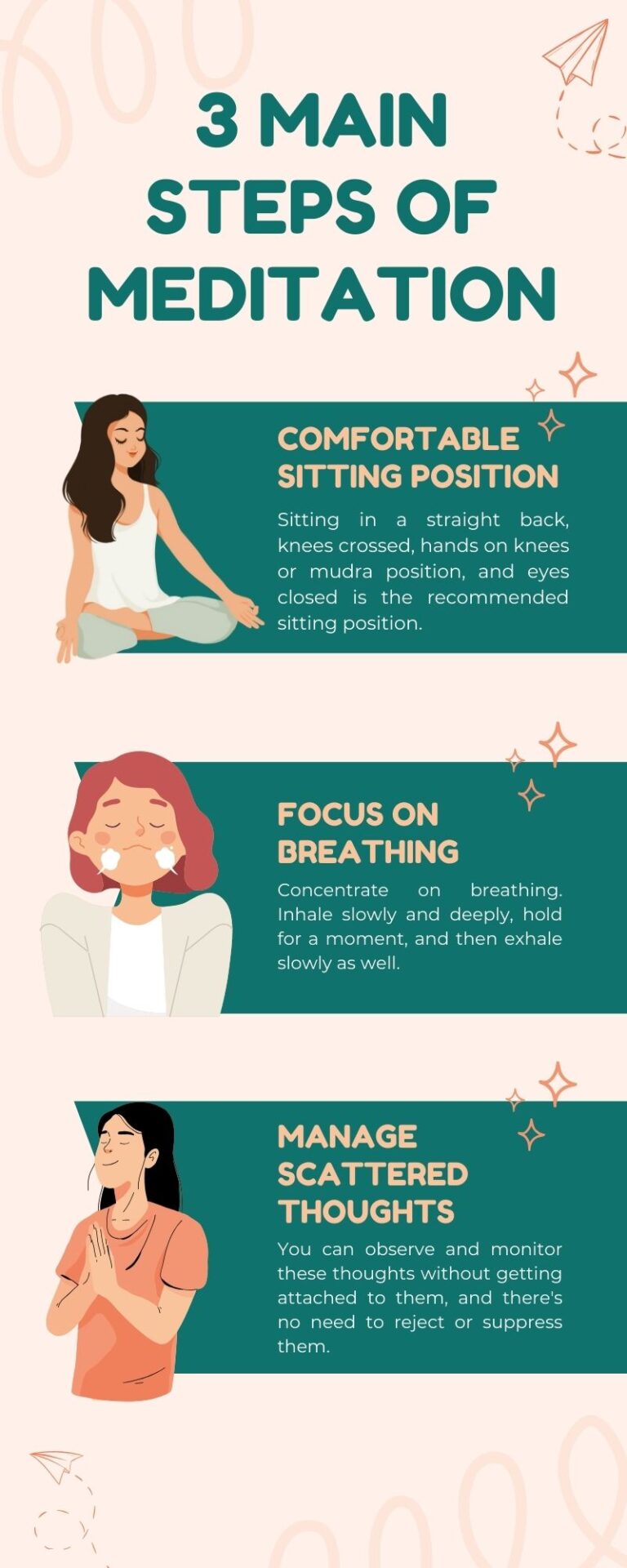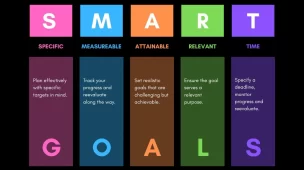Introduction
This guide is tailored specifically for beginners, intending to demystify and simplify the practice of mindfulness meditation, a practice that has stood the test of time, revered for its profound impact on mental clarity, emotional stability, and overall well-being.
Mindfulness meditation, at its essence, is a practice focused on cultivating a heightened state of awareness and presence in the moment.
This 10-step guide is designed to lead you gently into the world of mindfulness meditation.
It provides clear, step-by-step instructions, ensuring an accessible and insightful experience for beginners.
Embark on this transformative journey with us, as we explore the serene world of mindfulness meditation. Let this be your first step towards achieving inner peace and a more mindful way of living.
Table of Contents
Key Steps to Embracing Mindfulness Meditation: A Beginner’s Roadmap
Grasping the concept of being fully present and aware in each moment.
Setting up a quiet, comfortable area for your meditation practice.
Establishing a specific time each day for meditation, beginning with shorter sessions.
Choosing a stable and comfortable position for meditation, whether sitting, lying down, standing, or walking.
Concentrating on your breathing, using it as an anchor to remain presen
Noticing your thoughts without judgment and letting them pass like clouds in the sky
Whenever distracted, gently bringing your focus back to your breath.
Broadening your attention beyond breathing to include body sensations and sounds around you.
Practicing mindfulness in everyday activities like eating, walking, or listening.
Dealing with restlessness, drowsiness, or distractions with patience and refocusing on your breath.
Step 1: Understanding Mindfulness Meditation
The first step in your journey towards mastering mindfulness meditation begins with understanding its essence.
Mindfulness meditation is more than just a technique; it is a way of living, a method to bring one’s full attention to the present moment.
This form of meditation encourages practitioners to observe their thoughts, feelings, and bodily sensations in a non-judgmental manner, fostering a profound connection with the here and now.
At its core, mindfulness meditation is about awareness. It is about learning to be fully present in each moment, whether you’re eating, walking, or simply breathing.
Unlike other forms of meditation that may require chanting or visualization, mindfulness focuses on the simplicity of being.
This practice has roots in Buddhist teachings, but it has transcended religious and cultural boundaries to become a universally embraced method for enhancing mental well-being.
Studies have shown that regular mindfulness meditation can reduce stress, improve attention, decrease anxiety, and even lead to structural changes in the brain associated with enhanced cognitive and emotional well-being.
As a beginner, your goal in this first step is not to master mindfulness meditation immediately, but to understand what it entails and what it aims to achieve.
Step 2: Preparing Your Space for Mindfulness Meditation
Selecting Your Space: Choose a quiet and comfortable spot in your home where you are least likely to be disturbed.
It doesn’t need to be large; a small corner of a room can suffice.
The key is consistency; using the same space regularly for your mindfulness meditation can help condition your mind to relax and focus more easily.
Creating a Calm Atmosphere: Personalize your meditation space to make it calming and inviting. You might add a few simple items, like a cushion or a mat for comfort, and perhaps a blanket if you tend to feel cold.
Some people find that having a plant, a piece of inspirational art, or a small sculpture can help create a serene ambiance.
Remember, the goal is to create a distraction-free zone that promotes relaxation and focus.
Minimizing Distractions: Ensure your meditation space is away from noisy distractions.
Turn off electronic devices or put them in another room to avoid interruptions.
If you live in a noisy environment, consider using earplugs or a white noise machine to block out distracting sounds.
Lighting and Aromas: Soft, natural lighting can be soothing.
If possible, position your meditation space near a source of natural light, such as a window.
Gentle aromas from candles or essential oils like lavender or sandalwood can also enhance the meditative experience, aiding in relaxation and focus.
Accessibility: Your meditation space should be easily accessible.
If it’s difficult to get to or requires significant effort to set up each time, you might be less inclined to use it regularly.
Simplicity and ease of access are key.
Preparing your meditation space is not just about the physical environment; it’s about creating a mental sanctuary.
This space becomes a symbol of peace and mindfulness, a physical representation of your commitment to your practice.
As you progress through each mindfulness meditation session, this space will become an oasis of tranquility, a special place where you can retreat from the chaos of everyday life and reconnect with yourself.
In the next step, we will explore how setting a regular meditation schedule can further enhance your mindfulness journey.
Step 3: Setting a Regular Schedule
Consistency is key in mindfulness meditation, especially for beginners.
Establishing a regular schedule not only fosters discipline but also enhances the benefits of the practice.
Choose a specific time of day for your meditation; many find early morning or evening to be ideal, as these times generally offer quieter moments.
However, the most important aspect is what works best for you and fits into your daily routine.
Start with short sessions, perhaps 5 to 10 minutes, and gradually increase the duration as you become more comfortable with the practice.
Consistent, brief sessions are more beneficial than sporadic, longer ones.
By integrating mindfulness meditation into your daily schedule, you create a habit, allowing the practice to become a natural part of your life, leading to a more mindful, balanced existence.
Step 4: Adopting a Comfortable Position
In mindfulness meditation, comfort is crucial. The position you choose should enable you to remain alert yet relaxed.
For beginners, finding a posture that balances these aspects is key to a sustainable practice. Here are some options:
Sitting: The most common meditation pose is sitting. Use a cushion or chair, ensuring your back is straight but not stiff.
Place your feet flat on the ground if you’re on a chair, or cross your legs comfortably if you’re on the floor. Hands can rest gently on your knees or lap.
Lying Down: If sitting is uncomfortable, lying down is a viable alternative. Lie flat on your back, preferably on a yoga mat or a firm surface, with your arms at your sides and palms facing up.
Be mindful that this position can lead to drowsiness, so it’s important to remain alert.
Standing: Standing meditation is another option, ideal for those who feel too drowsy in sitting or lying positions.
Stand with your feet shoulder-width apart, knees slightly bent, and arms hanging naturally by your sides.
Walking: Walking meditation is a form of mindfulness practice where you focus on the movement of walking.
It combines physical activity with meditation and can be especially beneficial for those who prefer a more active form of meditation.
Remember, there is no “perfect” posture for meditation. The goal is to find a position where you can remain comfortable for the duration of your practice without falling asleep.
The right posture is one that allows you to be both alert and relaxed, facilitating deeper awareness and focus during your mindfulness meditation sessions.
Step 5: Focusing on Your Breath
Central to mindfulness meditation is the focus on the breath, which serves as an anchor to the present moment.
For beginners, this is a fundamental technique to master. Start by taking slow, deep breaths, inhaling through your nose, and exhaling through your mouth.
Feel the air move in and out of your body, noticing the rise and fall of your chest or the sensation of air passing through your nostrils.
As you focus on your breath, you’ll find that your mind may wander. This is normal.
Each time it happens, gently redirect your attention back to your breathing.
This act of returning to your breath is where the magic of mindfulness meditation lies.
It trains your mind to maintain focus, enhancing your ability to remain present and aware.
Over time, this practice of coming back to the breath builds a foundation of mindfulness that extends beyond your meditation sessions into everyday life.
Step 6: Observing Your Thoughts
A key aspect of mindfulness meditation is learning to observe your thoughts without judgment.
As you meditate, you’ll notice your mind may wander, drifting to various thoughts about the past, present, or future.
This wandering is natural and an inherent part of the human mind.
The practice here is not to suppress or engage with these thoughts but to observe them as they arise, acknowledging their presence, and then gently letting them go. Imagine your thoughts as leaves floating down a river or clouds passing in the sky.
Observe them come and go without attaching emotions or judgments to them.
This non-judgmental observation teaches you to recognize the transient nature of thoughts, helping you gain insight into the patterns of your mind.
With time and practice, you’ll learn to observe your thoughts without getting caught up in them, cultivating a sense of mental clarity and calmness.
Step 7: Returning to Your Breath
In mindfulness meditation, it’s inevitable for your attention to drift away from your breath.
The art of returning to your breathing is a vital skill.
When you notice your mind wandering, acknowledge it without criticism and gently guide your focus back to the rhythm of your breath.
One technique is to softly label the diversion as “thinking” or “wandering” and then ease your attention back to the sensation of breathing.
This simple act of labeling provides a moment of awareness and a gentle transition back to your breath.
Patience and persistence are crucial here.
The process of returning to your breath is not a sign of failure but a practice of mindfulness itself.
Each time you redirect your attention, you strengthen your mindfulness muscle.
It’s a practice of recognizing distraction and choosing to return to the present moment, nurturing a deeper sense of awareness and control over your mind.
Step 8: Expanding Your Awareness
Once you’ve become comfortable focusing on your breath, the next step in mindfulness meditation is to expand your awareness beyond just breathing.
Start to bring your attention to other sensations in your body.
Notice the points of contact between your body and the chair or floor.
Feel the weight of your hands in your lap. Observe any tension or relaxation in different parts of your body.
You can also extend your awareness to sounds. Listen to the ambient noises around you – the distant hum of traffic, the gentle rustle of leaves, or the subtle sounds within your room.
The goal is not to analyze these sensations or sounds but to simply be aware of them as they occur.
This expanded awareness cultivates a deeper connection with the present moment and helps you become more attuned to the subtleties of your everyday experience.
It’s about being fully present in the now and embracing every aspect of your current experience without judgment.
Step 9: Incorporating Mindfulness into Daily Life
Mindfulness doesn’t end with your meditation session; it’s a skill that can enhance every part of your life.
Start integrating mindfulness into your daily activities.
For instance, practice mindful eating by paying close attention to the taste, texture, and aroma of your food, eating slowly and savoring each bite.
When walking, focus on the sensation of your feet touching the ground, the rhythm of your steps, and the sounds and sights around you.
Mindful listening is another powerful practice. When conversing with someone, give them your full attention.
Notice their words, tone, and expressions without thinking about how you’ll respond. This not only improves communication but also deepens your relationships.
Incorporating these small acts of mindfulness into your routine allows you to live more fully in the present moment, bringing greater awareness, calmness, and joy into everyday life.
Step 10: Overcoming Common Challenges
As you embark on your mindfulness meditation journey, encountering challenges like restlessness, drowsiness, or distraction is common. It’s important to approach these hurdles with patience and understanding.
If you feel restless, acknowledge the sensation and gently bring your focus back to your breath or body sensations. For drowsiness, try meditating in a more upright position or at a time of day when you feel more alert.
If distractions arise, recognize them, and then refocus on your breath without self-judgment.
Remember, these challenges are part of the learning process. Each obstacle offers an opportunity to deepen your practice and understanding of mindfulness.
With time and consistent practice, you’ll develop the skills to navigate these challenges effectively.

Conclusion
Mindfulness meditation is a journey towards inner peace and awareness, and this 10-step guide is designed to help beginners navigate this path with ease and confidence.
Remember, the essence of mindfulness is presence and awareness in the moment, cultivated through practices like focusing on the breath, observing thoughts, and expanding awareness.
Consistency and patience are vital.
The more you practice, the more natural mindfulness will become.
Challenges are an essential component of learning, so don’t let them demotivate you.
As you continue on this journey, you’re invited to explore deeper aspects of mindfulness, integrating it into all facets of your life.
Mindfulness is not just a practice but a way of living, offering a profound sense of peace, clarity, and connection to the world around you.
Embrace this journey with an open heart and mind, and discover the transformative power of mindfulness meditation.
More Articles About Mindfulness:
- Getting Started With Mindfulness
- Benefits of Mindfulness
A 7 Second At Home Ritual
Scientifically verified by four neuroscience Studies …
Thar Revs up Your Brain Power













